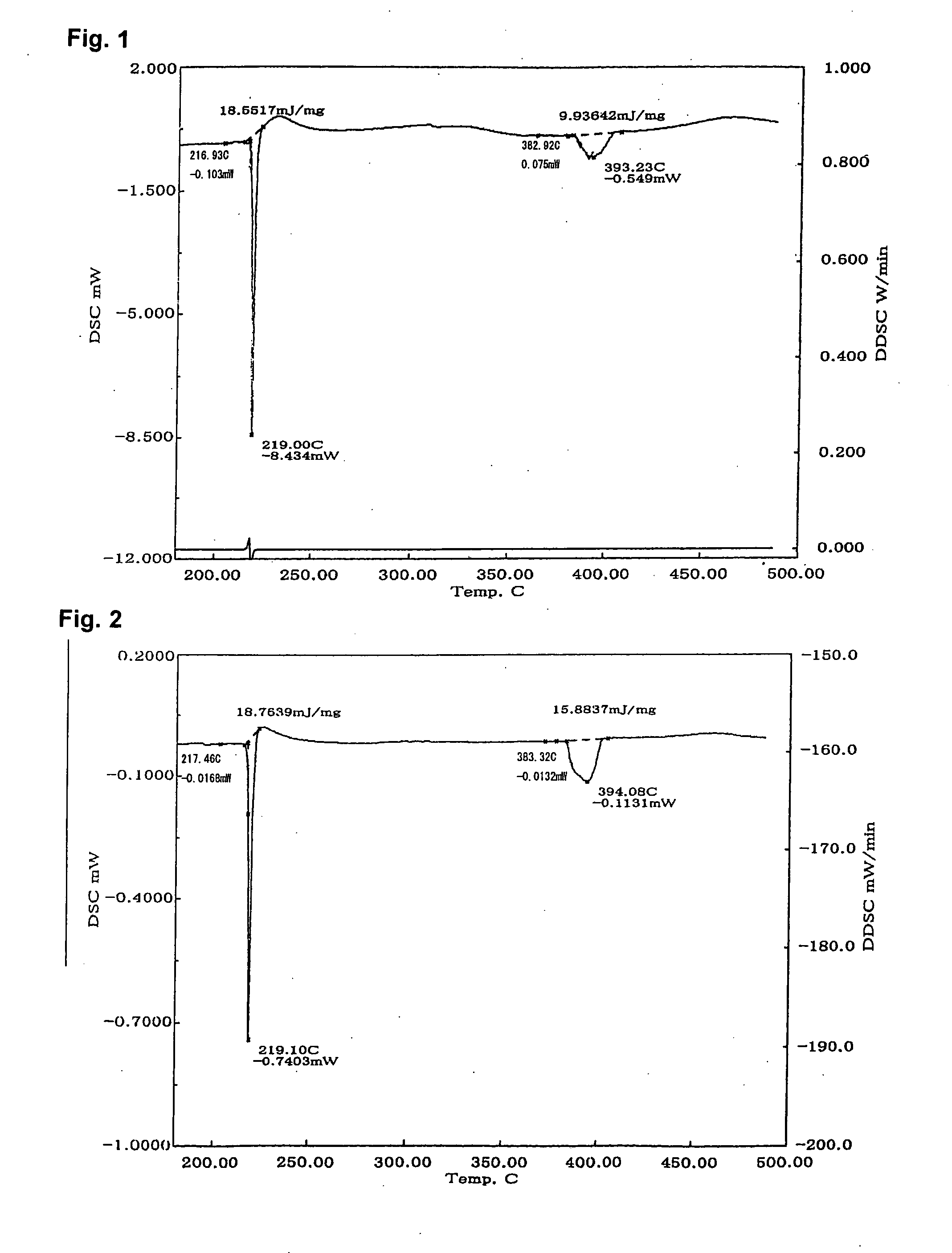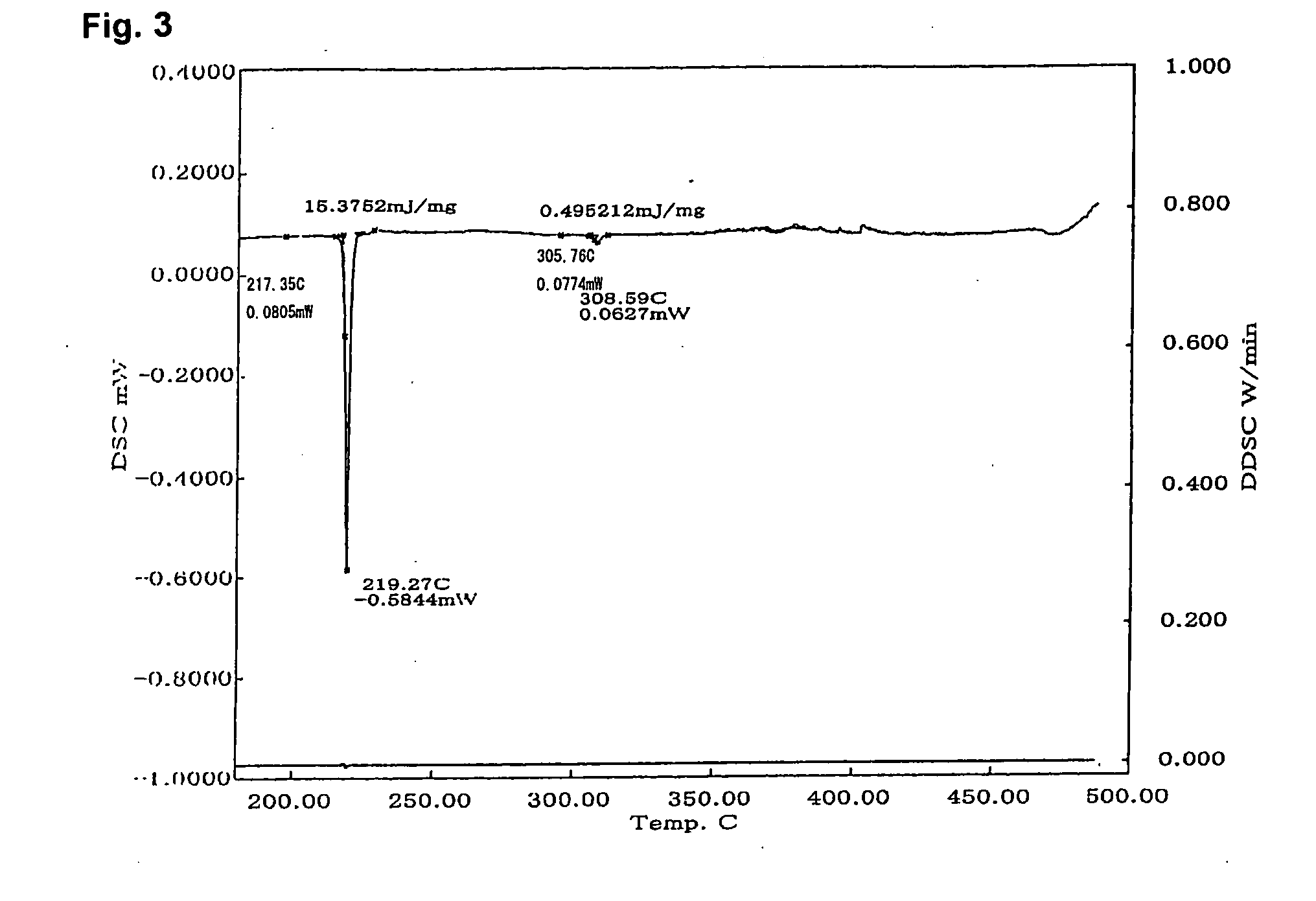Solder Paste
a technology of solder paste and slurry, which is applied in the direction of solventing apparatus, manufacturing tools, transportation and packaging, etc., can solve the problems of poor wettability of paste, inability to actually use paste, and poor wettability of solder itself, so as to facilitate the molten low melting point metal, the length of contact between a solder alloy and the lands of printed circuit boards or the terminals of electronic parts is increased, and the effect of improving the wettability
- Summary
- Abstract
- Description
- Claims
- Application Information
AI Technical Summary
Benefits of technology
Problems solved by technology
Method used
Image
Examples
example 1
[0038]1. Low melting point alloy powder (particle diameter of powder: 2-15 μm)[0039]1) Sn powder[0040]2) Sn-3.5 mass % Ag powder[0041]3) Sn-0.7 mass % Cu powder[0042]4) Sn-5 mass % Sb powder[0043]5) Sn-58 mass % Bi powder[0044]6) Sn-3.5 mass % Ag-0.5 mass % Cu powder[0045]7) Sn-58 mass % Bi-0.8 mass % Ag powder[0046]8) Sn-0.7 mass % Cu-0.3 mass % Sb powder[0047]9) Sn-5 mass % Sb-0.05 mass % Ni-0.1 mass % Co powder
2. High melting point powder (particle diameter of powder: 2-15 μm; the Ni content is a coating of the powder formed by electroless plating and having a composition of 95 mass % Ni-5 mass % P)[0048]1) Cu-0.2 mass % Ni powder[0049]2) Cu-1.0 mass % Ni powder[0050]3) Cu-1.5 mass % Ni powder[0051]4) Cu-2.0 mass % Ni powder[0052]5) Cu-7.0 mass % Ni powder[0053]6) Cu-3.0 mass % Sn powder[0054]7) Ag-0.5 mass % Ni powder[0055]8) Ag-3.0 mass % Ni powder[0056]9) Ag-7.0 mass % Ni powder[0057]10) Cu powder[0058]11) Ag powder
3. Mixed powder
[0059]The above-described low melting point all...
example 2
[0091]The amount of intermetallic compounds formed by each solder paste prepared in Example 1 was evaluated by measuring heat absorption using a DSC.
TABLE 11st1st2ndsoliduspeaksolidus2nd1st heat2nd heatLow m.p.High m.p.temp.temp.temp.peakabsorptionabsorptionpowderpowder(° C.)(° C.)(° C.)temp.(mJ / mg)(mJ / mg)Inventive1SnCu—0.2Ni22723138640522.413.52SnCu—2.0Ni22723138540723.111.33Sn—3.5AgCu—0.2Ni21721938940220.614.14Sn—3.5AgCu—1.0Ni21721938741518.59.25Sn—3.5AgCu—1.5Ni21721940841923.7106Sn—3.5AgCu—2.0Ni21721940541622.110.27Sn—0.7CuCu—1.0Ni22723137940121.811.68Sn—3Ag—0.5CuCu—1.0Ni21721939540524.413.89Sn—3.5Ag—8InCu—1.0Ni19720839140819.613.610Sn—0.7Cu—0.3SbCu—1.0Ni22623038640222.812.411SnAg—0.5Ni22122235837722.912.912SnAg—3.0Ni22122335235823.113.1Comparative1SnCu23223338539522.614.22SnCu—7.0Ni23223330530818.20.43Sn—3.5AgCu21721939440820.613.74Sn—3.5AgCu—7.0Ni21721930530815.30.55SnAg221223————6SnAg—7.0Ni23123430430920.30.5
1. Test method
[0092]1. Each of the solder pastes prepared in Example ...
example 3
[0101]The wettability of each solder paste prepared in Example 1 was evaluated from the molten state of a piece of solder at various temperatures with various heating times.
TABLE 2Low m.p.High m.p.powderpowderWettabilityInventive1SnCu—0.2Ni2SnCu—2.0Ni3Sn—3.5AgCu—0.2Ni4Sn—3.5AgCu—1.0Ni5Sn—3.5AgCu—1.5Ni6Sn—3.5AgCu—2.0Ni7Sn—0.7CuCu—1.0Ni8Sn—3Ag—0.5CuCu—1.0Ni9Sn—3.5Ag—8InCu—1.0Ni10Sn—0.7Cu—0.3SbCu—1.0Ni11SnAg—0.5Ni12SnAg—3.0NiComparative1SnCu2SnCu—7.0Ni3Sn—3.5AgCu4Sn—3.5AgCu—7.0Ni5SnAg6SnAg—7.0Ni
1. Test method
[0102]1. Each of the solder pastes prepared in Example 1 was printed with a squeegee on 50 mm×50 mm×0.8 mm alumina substrates through a metal mask having a thickness of 0.15 mm and having an opening measuring 30 mm×30 mm.
[0103]2. The alumina substrate was heated for 30 seconds or 120 seconds atop a solder bath set to 270° C. to obtain a solder piece bonded to the substrate.
2. Test results
[0104]The resulting solder pieces are shown in Table 2.
[0105]In Comparatives 2, 4, and 6, the s...
PUM
| Property | Measurement | Unit |
|---|---|---|
| mass % | aaaaa | aaaaa |
| mass % | aaaaa | aaaaa |
| liquidus temperature | aaaaa | aaaaa |
Abstract
Description
Claims
Application Information
 Login to View More
Login to View More - R&D
- Intellectual Property
- Life Sciences
- Materials
- Tech Scout
- Unparalleled Data Quality
- Higher Quality Content
- 60% Fewer Hallucinations
Browse by: Latest US Patents, China's latest patents, Technical Efficacy Thesaurus, Application Domain, Technology Topic, Popular Technical Reports.
© 2025 PatSnap. All rights reserved.Legal|Privacy policy|Modern Slavery Act Transparency Statement|Sitemap|About US| Contact US: help@patsnap.com



